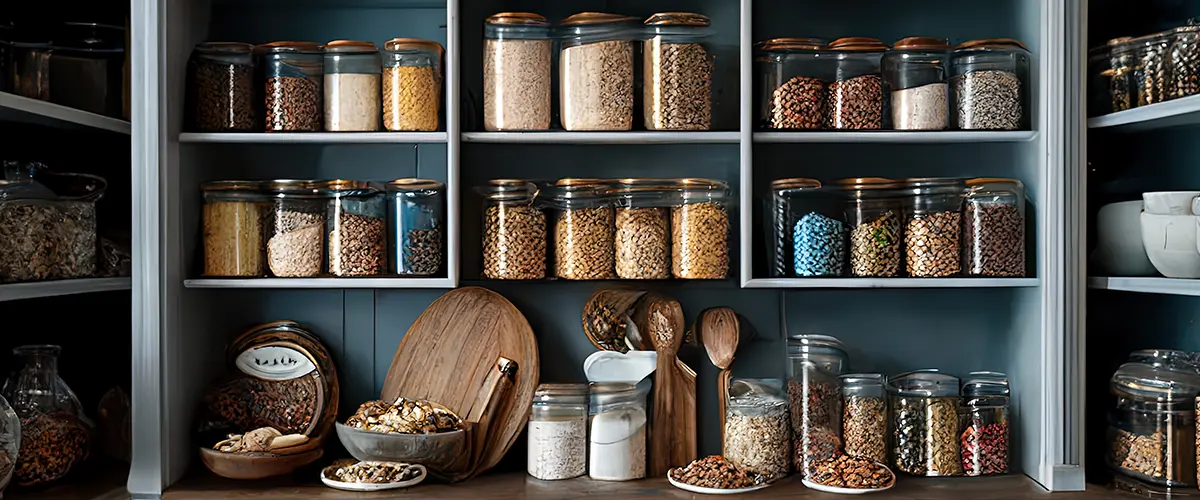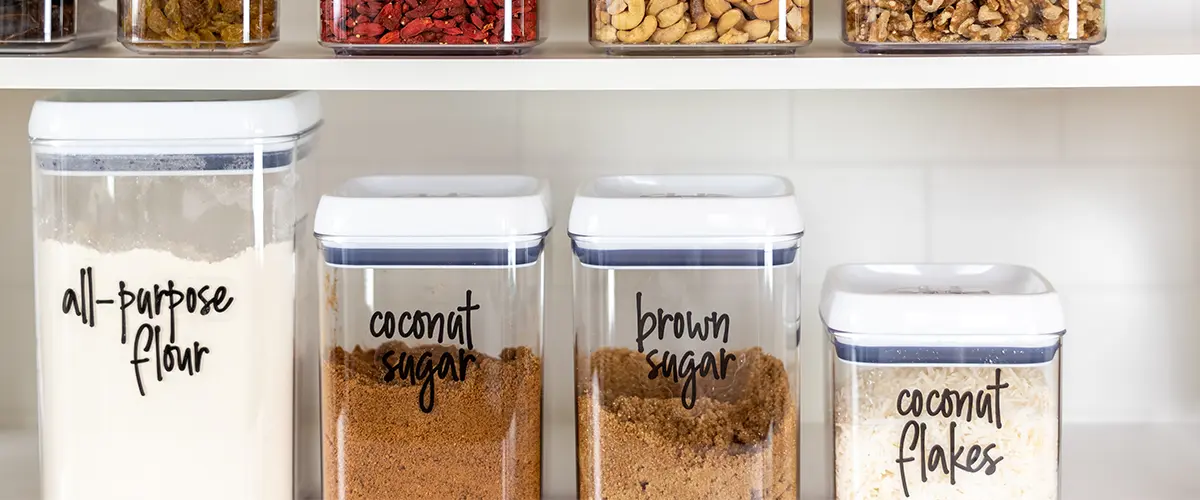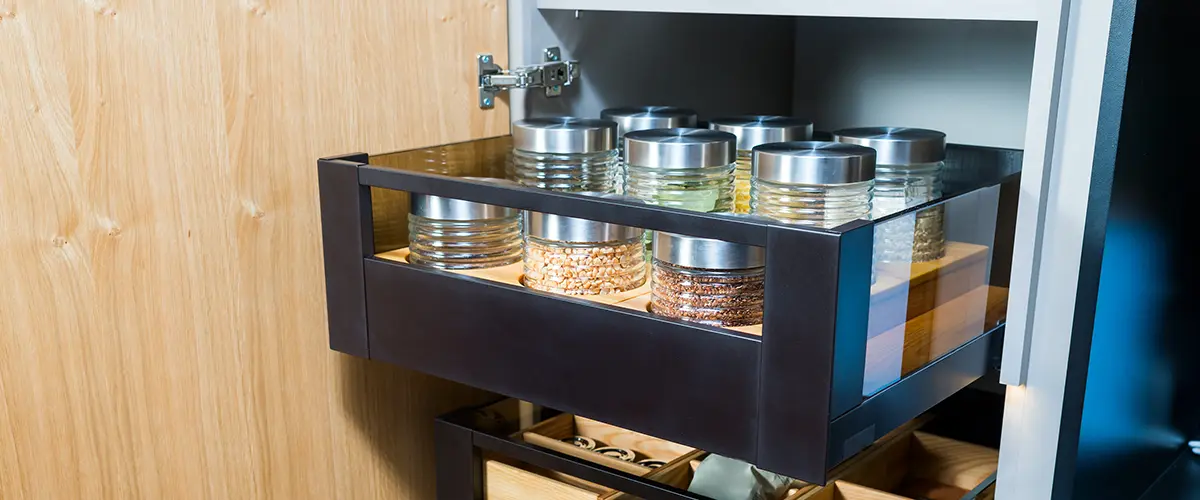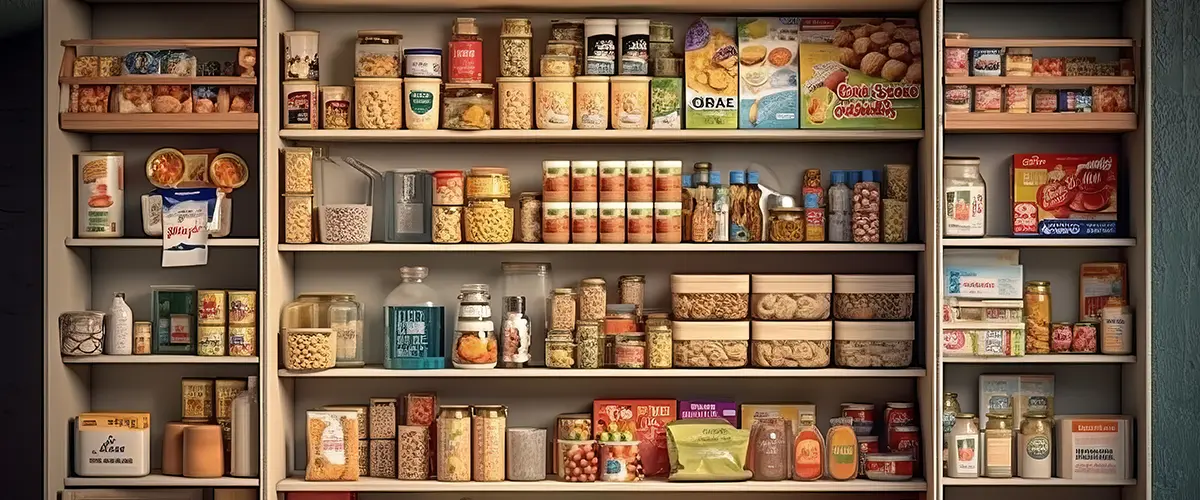A well-organized kitchen pantry can be a game-changer for your cooking routine. No more rummaging through cluttered shelves to find ingredients or feeling overwhelmed by the chaos. In this comprehensive guide, we’ll walk you through the process of organizing your kitchen pantry, from top to bottom, so you can maximize space, reduce food waste, and streamline your culinary experience.

1. Assess and Empty Your Pantry
Before you dive into the organization process, it’s important to start with a clean slate. Empty out your pantry completely and assess its contents. This step allows you to see what you have, what’s expired, and what needs to be prioritized.
2. Categorize Your Items
Divide your pantry items into categories such as grains, canned goods, spices, baking essentials, snacks, and more. This step will help you visualize the layout of your pantry and determine the best placement for each category.
3. Utilize the Top Shelf Pantry Storage
The top shelf of your pantry can be a valuable storage space if used wisely. Here’s how to make the most of it:
3.1. Light Items and Special Occasion Supplies
The top shelf is ideal for items that you don’t use on a daily basis. Store light items such as paper towels, disposable plates, and napkins here. Additionally, reserve this space for special occasion supplies like decorations or serving platters that are only needed occasionally.
3.2. Bulk Items
If you buy items in bulk, like large bags of rice or pasta, the top shelf can be a great spot to keep them. Just make sure to use clear containers or labels to easily identify the contents.
3.3. Kitchen Appliances
If your pantry has enough height, consider placing smaller kitchen appliances like blenders, food processors, or slow cookers on the top shelf. This frees up counter space and keeps your pantry visually appealing.

4. Invest in Storage Solutions
Maximize the space in your pantry with the help of smart storage solutions:
4.1. Adjustable Shelving Units
Install adjustable shelves to create customized storage areas that accommodate items of various sizes. This allows you to modify the shelf heights as your pantry needs change.
4.2. Clear Storage Containers
Use clear airtight containers to store dry goods like flour, sugar, and cereal. Not only do these containers keep your food fresh, but they also make it easy to see when supplies are running low.
4.3. Door Organizers
Make use of the inside of your pantry door by attaching door organizers. These can hold items like spices, condiments, or even small snacks, freeing up shelf space.
5. Arrange Items Strategically
Efficient arrangement of items in your pantry can save you time and make cooking a breeze:
5.1. Eye-Level Accessibility
Keep frequently used items at eye level for easy access. This includes everyday staples like spices, oils, and frequently used canned goods.
5.2. FIFO (First In, First Out)
Arrange items in a way that encourages you to use older items before newer ones. This prevents food waste by ensuring that items with shorter shelf lives are used first.
5.3. Group Similar Items
Group similar items together to create designated zones. For instance, place all baking supplies in one area and snacks in another. This minimizes the time spent searching for items.

6. Regular Maintenance
To sustain your organized pantry, conduct regular maintenance:
6.1. Scheduled Check-ups
Set aside time every few months to review the contents of your pantry. Remove expired items and take note of items that need replenishing.
6.2. Re-adjustment
As your cooking habits change or your family grows, your pantry needs may shift. Don’t hesitate to re-adjust shelf placement and categories accordingly.
6.3. Shopping List System
Place a small whiteboard or notepad inside the pantry to jot down items as they run out. This makes grocery shopping more efficient.

FAQs About How To Organize A Kitchen Pantry
What is the best way to organize a pantry?
The best way to organize a pantry involves a systematic approach that combines decluttering, categorizing, and strategic placement.
Start by emptying your pantry to assess its contents. Categorize items into groups like grains, canned goods, spices, snacks, and more. Utilize adjustable shelving units and clear storage containers to optimize space.
Arrange items based on frequency of use and implement a FIFO (First In, First Out) system to minimize food waste. Regular maintenance is crucial to sustaining your pantry’s organization.
How do I maximize my pantry space?
To maximize pantry space, consider these strategies:
- Use adjustable shelving units to accommodate items of varying sizes.
- Utilize the often overlooked top shelf for items like bulk purchases, light supplies, and infrequently used kitchen appliances.
- Invest in clear storage containers to create a uniform and efficient storage system.
- Attach door organizers for small items like spices and condiments.
- Group similar items together and make use of vertical space by using stackable containers or risers.
- Regularly assess your pantry’s contents to remove expired items and reorganize as needed.
What categories should I have in my pantry?
When categorizing your pantry, consider the following categories:
- Grains: Store items like rice, pasta, quinoa, and oats in clear containers.
- Canned Goods: Keep canned vegetables, fruits, soups, and sauces together.
- Spices and Seasonings: Arrange spices in alphabetical order for easy access.
- Baking Essentials: Store flour, sugar, baking powder, and other baking supplies together.
- Snacks: Group snacks like chips, crackers, and granola bars in one area.
- Condiments and Oils: Keep items like ketchup, mustard, and cooking oils together.
- Special Occasion Supplies: Reserve a section for items used only during special events.
- Kitchen Appliances: Use the top shelf for smaller appliances like blenders or slow cookers.
- Beverages: Store coffee, tea, and other beverages in a designated area.
- Miscellaneous: Create a catch-all category for miscellaneous items.
Contact WA’s Kitchen Pantry Pros
If you want to upgrade your pantry with top-tier organizers and customized solutions such as sliding baskets, adjustable shelves, spice racks, and more, drop us a message, and we’ll get back to you for a complimentary in-home kitchen pantry design.
